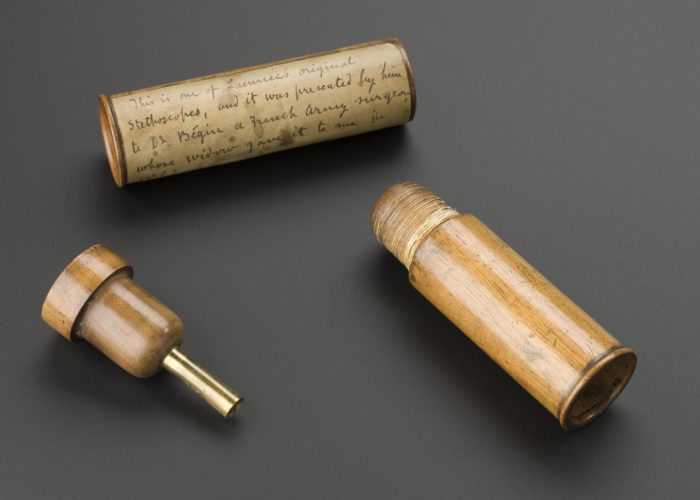Laennec stethoscope
Theme: Economic and technological revolution, Medicine, science and the people
Today, the stethoscope is a fundamental and indispensable part of a doctor’s kit, often providing the first clues to the nature of a variety of chest complaints. But in the early 1800s, simple diagnostic tools like this had yet to be developed. The invention of the stethoscope by René Laënnec (1781 – 1826) revolutionised the capacity of the physician (doctor) to diagnose chest, heart and lung complaints.
Diseases of the lungs and heart were a great threat to people in Britain during the Age of Revolution. Tuberculosis, pneumonia, cardiac problems and bronchitis were rife in undernourished and overworked communities, and there were few treatments available beyond alcohol, opium, blood-letting and herbal remedies. Scientists were still developing their understanding of how the human body worked; germs had yet to be identified, antiseptics and antibiotics were still a development of the future and diagnostic tools were often limited in effectiveness or precision.
René Laënnec later explained his invention of the stethoscope, recalling that in 1816 he was examining a female patient with heart problems. Considering it improper to listen to her heart in the usual way (by putting his ear to her chest or tapping) and unable to feel the rhythm effectively due to her weight, he had the ingenious idea of using a tube. This would create an acceptable distance between him and the patient but still allow him to hear what was happening inside.
Laënnec rolled a piece of paper into a cylinder and placed one end on the patient’s chest and the other to his ear. This tube not only allowed him to listen to the patient’s heart, but also helped him focus on a more specific area of the chest and to hear the sounds more clearly and distinctly than before.
His discovery was so useful, he went on to develop a version which he could carry with him, creating a more robust tube from wood. He called this simple piece of equipment a stethoscope (from the Greek stethos for chest and skopos for examination). Eventually, it was adopted by many doctors who used it to detect wheezing, rattling, breath sounds and a whole variety of cardiac noises inside their patients’ chests. It was also used to listen to a baby’s heartbeat in the uterus and to sounds made by the bowels in the abdomen.
The modern stethoscope, with two earpieces, has changed very little since its invention in the 1850s.
Did you know..?
A type of stethoscope called a geophone was used during World War I to listen in to enemy troops from inside tunnels dug under enemy lines.
Use our Classroom resources to investigate this object and the theme of Medicine further.
Highlights:
- Using objects, artworks and other sources to find out about the past
- Enquiry: Was there a medical revolution during the Age of Revolution?
- Enquiry: What factors drove change in medical practice during the Age of Revolution?
- Enquiry: Was change in medical practice evolutionary or revolutionary during the Age of Revolution?
- Mystery objects
And much more…
Sources & acknowledgements
This object description and its related educational resources were researched and written by our team of historians and education specialists. For further information see the item’s home museum, gallery or archive, listed above.
-
Did you know..?
A type of stethoscope called a geophone was used during World War I to listen in to enemy troops from inside tunnels dug under enemy lines.
-
Education overview
You can access a range of teachers resources related to this object and more on our education page.
Please also see our glossary of terms for more detailed explanations of the terms used.
-
Curatorial info
- Originating Museum: Science Museum, London
- Accession Number: A106078
- Production Date: c.1820
- Creator: René Théophile Hyacinthe Laennec
- Material: whole, brass, whole, string and whole, wood
- Original record
-
Use this image
You can download this image for personal and educational use but please take note of the license type and rights holder information.
- Rights Holder: Science Museum Group
- License Type:



